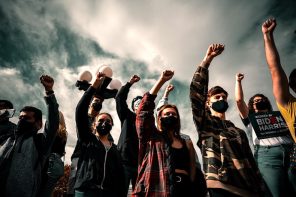A new report shows that acceptance of gay and lesbian rights by the general population is on the rise, but that more conservative clergy are not going down without a fight—increasingly using their pulpits as a forum to preach against homosexuality.
The report, from Public Religion Research Institute (PRRI), analyzes and assesses more than two decades of polling results from the Pew Research Center on attitudes about gay and lesbian people and issues such as marriage equality, civil unions, adoption, and military service.
Overall, support for civil unions has increased 12 points from 45 percent in 2003 to 57 percent in 2009. The support for marriage for gays and lesbians is also gaining support, but more slowly. Thirty percent supported it in 2003, with an 8-point gain by January 2010 to 38 percent. Support has also grown, though not as swiftly, for adoption rights, rising eight points from 38 percent in 2003 to 46 percent in 2008. Allowing open military service has been favored by a 52 percent majority since 1994 and has risen nine points to 61 percent this year.
Dr. Clyde Wilcox, professor of government at Georgetown University, during a press conference to release the report, called this trend a “tidal wave of change” especially in religious communities.
“There are very few things that have changed in American public opinion as dramatically as support for gay and lesbian rights. Since 1994 the numbers really pop off the charts over a 20-year period. These trends occur across all religious communities. So the white evangelical fundamentalists today are far more accommodating to gays and lesbians than they were twenty years ago. So are Catholics and mainline Protestants.”
Despite that growing accommodation, some more conservative religious leaders—especially those who see the Bible as the literal, inerrant, Word of God—are maintaining the orthodox line that homosexuality is a sin and they are using their pulpits to voice their opposition. PRRI’s research revealed that in 1996, when issues of same-sex marriage were but a whisper, only 36 percent of those who regularly attended church ever heard their clergy mention the subject. By 2006, when the battle over same-sex marriage was raging across the nation as many states had passed, or were preparing to pass, state constitutional bans, 52 percent of those in the pews each week heard their preacher talk about gays and lesbians and the law.
What they were hearing were not words of acceptance and tolerance. Instead, a 2003 Pew poll revealed that nearly three-quarters of them heard their preachers say “homosexuality should be discouraged.”
“The cautionary note that I take from the report is the continuing role that religion plays in anti-LGBT attitudes and behaviors in our country,” said Rebecca Voelkel, Director of the Institute for Welcoming Resources and Faith Work. “Two things I take from that: one, that it continues to be increasingly important for religious folks, as religious folks, need to be speaking on behalf of LGBT persons, and that we need to have a lot more data around the ways in which religion impacts people’s support of LGBT issues.”
For those seeking full inclusion of gays and lesbians in both society and the church the analysis of the research has good news. It reveals that as the next generation comes into prominence, support for gay rights, including the right to marry, will only increase.
Wilcox notes that “young people are 15 to 25 points more liberal than the older people in our society.”
He said that, twenty years ago, when he introduced the topic of homosexuality in his class people would become nervous and uncomfortable. Now, he says “it’s been five years since I’ve had any student that opposes same-sex marriage, so this notion of a generation shift is very, very big.”
Wilcox adds one caveat: while youth are more liberal on the question of gay and lesbian rights, it doesn’t mean they’re more liberal across the board.
“The young cohort is not actually more pro-choice on abortion.”
So while one victory comes into focus, still another battle looms.




